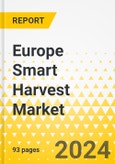This report comes with 10% free customization, enabling you to add data that meets your specific business needs.
Market Introduction
The market for smart harvests in Europe is expanding significantly as the region uses more and more cutting-edge agricultural technologies to increase sustainability, efficiency, and productivity. Traditional farming practices are being transformed by smart harvesting solutions that integrate robotics, machine learning, and artificial intelligence (AI) in response to the growing demand for food and the need to optimize resources. Precision harvesting is made possible by these technologies, which increase crop yield and quality while lowering reliance on labor.Government programs that support food security and sustainable agriculture are important factors propelling market growth. The adoption of automated harvesting systems is being accelerated by the European Union's emphasis on smart farming and its funding initiatives for agri-tech innovations. The harvesting process is also being further optimized by the increasing use of autonomous harvesting equipment and IoT-enabled sensors, which improve real-time decision-making.
As climate change and environmental concerns affect farming methods, smart harvest technologies are essential to long-term sustainability. The Europe Smart Harvest Market is expected to grow significantly due to ongoing developments in automation and AI-driven analytics, which will transform contemporary farming and aid in the region's shift to a more productive and environmentally friendly agricultural industry.
Market Segmentation:
Segmentation 1: by Site of Operation
- On Field
- Controlled Environment: GreenhousesIndoor Farms
Segmentation 2: by Crop Type
- Grain Crops
- Fruits and Vegetables
- Others
Segmentation 3: by Product
- Robotic Harvester
- Smart Harvester: Self-Propelled and Tractor Mounted
- Harvest Dynamic Monitoring
Segmentation 4: by Country
- Germany
- U.K.
- France
- Italy
- Spain
- Rest-of-Europe
How can this report add value to an organization?
Product/Innovation Strategy: This report provides a comprehensive product/innovation strategy for the Europe smart harvest market, identifying opportunities for market entry, technology adoption, and sustainable growth. It offers actionable insights, helping organizations leverage smart harvest to meet environmental standards, gain a competitive edge, and capitalize on the increasing demand for eco-friendly solutions in agriculture.Growth/Marketing Strategy: This report offers a comprehensive growth and marketing strategy designed specifically for the Europe smart harvest market. It presents a targeted approach to identifying specialized market segments, establishing a competitive advantage, and implementing creative marketing initiatives aimed at optimizing market share and financial performance. By harnessing these strategic recommendations, organizations can elevate their market presence, seize emerging prospects, and efficiently propel revenue expansion.
Competitive Strategy: This report crafts a strong competitive strategy tailored to the Europe smart harvest market. It evaluates market rivals, suggests methods to stand out, and offers guidance for maintaining a competitive edge. By adhering to these strategic directives, companies can position themselves effectively in the face of market competition, ensuring sustained prosperity and profitability.
Key Market Players and Competition Synopsis
The companies that are profiled in the report have been selected based on inputs gathered from primary experts and analyzing company coverage, product portfolio, and market penetration.Some of the prominent names in this market are:
- Agrobot
- Dogtooth Technologies Limited
- OCTINION
- Organifarms GmbH
- AVL Motion B.V.
- Fieldwork Robotics
- AMB Rousset
This product will be delivered within 3-5 business days.
Table of Contents
Companies Mentioned
- Agrobot
- Dogtooth Technologies Limited
- OCTINION
- Organifarms GmbH
- AVL Motion B.V.
- Fieldwork Robotics
- AMB Rousset
Table Information
| Report Attribute | Details |
|---|---|
| No. of Pages | 83 |
| Published | February 2025 |
| Forecast Period | 2024 - 2033 |
| Estimated Market Value ( USD | $ 1.59 Billion |
| Forecasted Market Value ( USD | $ 3.1 Billion |
| Compound Annual Growth Rate | 7.6% |
| Regions Covered | Europe |
| No. of Companies Mentioned | 7 |









